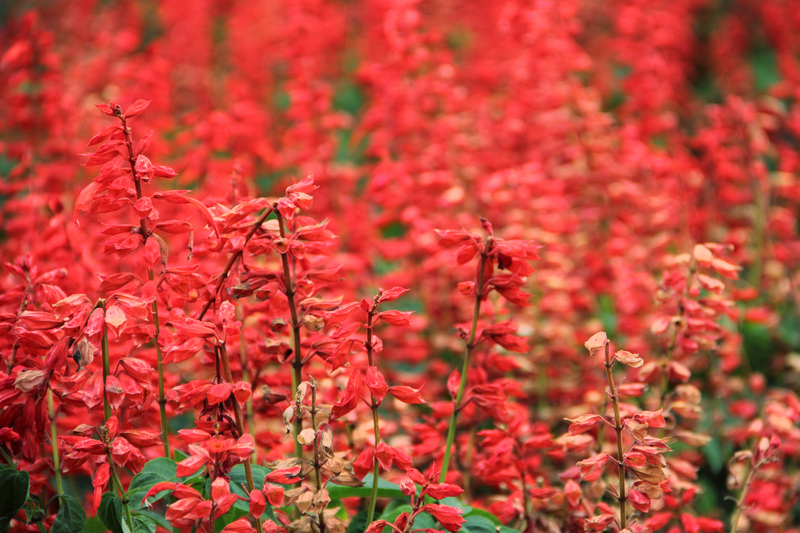Winterizing Your Garden: Essential Plant Protection Strategies
Posted on 04/06/2025
Winterizing Your Garden: Essential Plant Protection Strategies
As the crisp air of late autumn settles in and frost glimmers on the morning grass, it's a telltale sign that winter is just around the corner. Seasoned gardeners know that winterizing your garden is crucial to ensure the survival of cherished plants and guarantee lush growth in the next spring. In this comprehensive guide, we'll explore essential plant protection strategies you can implement to safeguard your garden through the harshest months.

Why Is Winterizing Your Garden Important?
Before delving into the specific winter plant protection methods, let's understand why it's vital to prepare your garden for winter:
- Frost and Freezing Temperatures: Can damage or kill tender plants, bulbs, and roots.
- Harsh Winds: Strip away moisture from leaves and soil, causing desiccation.
- Snow and Ice: Can break branches and weigh down plants.
- Pest and Disease Prevention: Cold can drive pests into lingering plant matter and spread diseases.
Winter garden preparation isn't just a chore; it's an investment in next season's success. By taking the right steps, you'll encourage vigorous springtime growth, enhance soil health, and protect your landscape's beauty.
When Should You Start Winterizing Your Plants?
Timing is key for winterizing plants. The ideal window is usually a few weeks before your region's first expected frost. This gives your garden time to settle and develop resilience before the deep cold sets in. Monitor your local weather, and use the USDA Hardiness Zone map to identify typical frost dates in your area.
Essential Winter Plant Protection Strategies
Let's dive into the most effective techniques for protecting your garden through the winter months.
1. Mulching: The First Line of Defense
Mulching is among the most critical plant protection strategies for winter. A thick mulch layer acts as insulation, moderating soil temperature, preventing frost heave, and conserving moisture. Here's how to do it right:
- Choose the Right Material: Straw, shredded leaves, pine needles, bark chips, or compost.
- Apply Adequately: Spread a 2 to 4-inch layer around the base of plants, trees, and over garden beds.
- Beware the Crown: Keep mulch a few inches from plant stems to avoid rot.
- Protect Roots: Mulch is especially crucial for perennials, trees, and shrubs.
Pro Tip: Mulch after the first hard frost so the ground is already cold, preventing rodents from burrowing.
2. Watering Before Frost
Plants that enter winter well-hydrated are more resilient. Water deeply before the ground freezes, especially for evergreens and newly planted trees or shrubs. Moist soil holds heat better than dry, protecting roots from deep freezing.
- Soak the root zone well.
- Water in the morning so excess can drain before nighttime freezing.
- Remember container plants--they dry out quickly and need vigilant hydration.
3. Pruning: Trim with Care
Pruning is both an art and a science in winter garden preparation. However, overzealous cutting back can expose plants to winter damage. Keep in mind:
- Remove Dead or Diseased Wood: Doing so prevents the spread of fungi and pests.
- Avoid Heavy Pruning: Especially for spring-flowering plants, as you may remove next year's buds.
- Prune Only When Dormant: After the plant has lost most leaves and entered dormancy.
Tip: Don't prune roses too aggressively--leave long canes for winter, and trim back in early spring.
4. Shielding Vulnerable Plants
Not all plants have the same tolerance for cold. Tender perennials, marginally hardy trees, and some shrubs need extra attention.
- Frost Cloths or Garden Blankets: Use these to cover and insulate plants on freezing nights.
- Burlap Wraps: Ideal for evergreens and sensitive shrubs battling wind burn.
- Cloche or Cold Frames: Protect young or delicate specimens and extend the growing season for edibles.
- Move Potted Plants Indoors: Group containers in sheltered spots, or bring them indoors to a garage or shed.
Pro Advice: Use stakes to create a frame before covering, preventing material from touching plant foliage directly.
5. Protecting Trees and Shrubs
Larger woody plants require different winter plant care strategies.
- Trunk Guards: Wrap young or thin-barked trunks with tree wrap to prevent splitting from freeze-thaw cycles and sunscald.
- Prune Snow-Damaged Branches: Remove broken limbs to prevent further splitting.
- Stake New Trees: Secure with stakes to withstand winter winds.
- Burlap Fences: For garden beds or shrubs exposed to road salt or blowing snow.
6. Winterizing Perennials and Bulbs
Winter protection for garden perennials and bulbs ensures vibrant blooms next spring. Follow these steps:
- Cut Back Herbaceous Perennials: Trim dead stems close to the ground once frost has wilted foliage.
- Lift Tender Bulbs: Dig up gladiolus, dahlias, and cannas before the ground freezes. Store in a cool, dry place.
- Insulate Hardy Bulbs: Leave tulips and daffodils in the ground but mulch well.
7. Winter Lawn Protection
Your lawn needs care, too!
- Mow Shorter: Final mow of the season to 2-2.5 inches height to prevent mold.
- Remove Leaves: Rake or mulch fallen leaves to prevent smothering and disease.
- Fertilize: A slow-release, high-potassium fertiliser supports root health over winter.
Additional Tips for Successful Winter Garden Preparation
Compost and Clean Up
Garden debris can harbor pests and diseases. Clear away spent annuals, rotten fruit, and dead plant matter. Compost healthy residue, but discard anything diseased.
- Sanitize Tools: Prevent spreading pathogens by disinfecting pruners and shovels.
- Empty Pots and Clean Planters: Store upside down or inside to prevent cracking.
Wildlife and Pollinator Support
While tidiness is important, consider leaving some seed heads and ornamental grasses for winter interest and as food for birds. Brush piles can serve as shelter for beneficial insects and small animals.
Protect Garden Structures and Irrigation Systems
Winterizing your garden includes prepping non-plant elements:
- Drain and Disconnect Hoses: Prevent freezing and bursting.
- Blow Out Irrigation Lines: Use compressed air for in-ground systems.
- Store Tools: Clean, oil, and hang up in a dry shed or garage.
Protecting Container Gardens
Potted plants are more susceptible to freezing because roots are above ground. For effective wintertime plant care in containers:
- Move pots against a south-facing wall for extra warmth.
- Wrap containers in bubble wrap or burlap for insulation.
- Group pots together to conserve heat.
- For fragile pots, bring them indoors or to a sheltered area.
Region-Specific Winterizing Strategies
Not all gardens face the same winter challenges. Customize your winter garden protection measures according to your climate:
- Harsh Northern Climates: Mulch heavily, use windbreaks, cover sensitive plants, and consider snow fencing.
- Mild or Coastal Regions: Watch out for cold snaps, occasional frost, and excessive rainfall leading to rot.
- Drought-Prone Winters: Continue deep watering during dry spells to keep roots hydrated.
If in doubt, check with your local extension service for guidance on optimal winterizing techniques in your area.

Common Mistakes to Avoid When Winterizing Your Garden
Even experienced gardeners can overlook key details in winter plant protection. Here are common pitfalls to avoid:
- Ignoring Late-Season Watering: Dry spells before winter can stress plants just when they need moisture most.
- Heavy Pruning at the Wrong Time: Pruning too early or late can damage woody plants.
- Improper Mulching: Piling mulch against stems leads to rot and invites rodents.
- Leaving Tools Wet and Dirty: Promotes rust, wear, and spread of diseases next year.
Don't Forget! Winter Isn't the End--It's a New Beginning
Winterizing your garden isn't just about survival--it sets the stage for spring's renewal. By employing proper plant protection strategies, you're giving your perennials, shrubs, and trees the very best chance to thrive once the snow melts. Make these traditions part of your gardening calendar and enjoy a healthier, more beautiful landscape year after year.
Final Thoughts: Start Planning Now for a Lush Spring
The secret to a successful winter garden transition--and a stunning spring--is to start winterizing your plants early, pay attention to the needs of each variety, and make plant protection an annual practice. From smart mulching and pruning to caring for containers and maintaining your equipment, these tips ensure your green space weathers winter's worst.
So, as the days grow short, grab your tools and embrace the opportunity to nurture your garden. Thoughtful preparation today means vibrant blossoms and abundant growth tomorrow!
Frequently Asked Questions About Winterizing the Garden
- Q: Can I use leaves as effective mulch for winter plant protection?
A: Yes! Shredded leaves make an excellent organic mulch, insulating roots and enriching the soil as they break down. - Q: Should I fertilize my garden in winter?
A: Avoid high-nitrogen fertilizers before winter; opt for a balanced, slow-release formula to support root strength rather than leafy growth. - Q: Is it necessary to dig up all bulbs during winterization?
A: Only tender bulbs (like gladiolus, dahlias) need lifting; hardy varieties such as tulips and daffodils can remain if well-mulched. - Q: How can I protect my newly planted trees?
A: Mulch well around the root zone, wrap the trunk to prevent sunscald and rodent gnawing, and water thoroughly before freeze-up.
Ready to give your garden the protection it needs? Let these expert winter garden preparation strategies ensure every plant weathers the cold and comes back even stronger in the spring!

